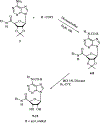Synthesis and biological activity of a new series of N6-arylcarbamoyl, 2-(Ar)alkynyl-N6-arylcarbamoyl, and N6-carboxamido derivatives of adenosine-5'-N-ethyluronamide as A1 and A3 adenosine receptor agonists
- PMID: 9703463
- PMCID: PMC9364910
- DOI: 10.1021/jm980147p
Synthesis and biological activity of a new series of N6-arylcarbamoyl, 2-(Ar)alkynyl-N6-arylcarbamoyl, and N6-carboxamido derivatives of adenosine-5'-N-ethyluronamide as A1 and A3 adenosine receptor agonists
Abstract
A new series of 1-(6-amino-9H-purin-9-yl)-1-deoxy-N-ethyl-beta-D-ribofuranuronamide++ +-b earing N-arylureas or N-arylcarboxamido groups at the purine 6 position and N-arylureas combined with halogens or alkynyl chains at the 2 position have been synthesized and tested for affinity at A1 and A2A adenosine receptors in rat brain membranes and at cloned rat A3 receptors expressed in CHO cells. The derivatives contained the 5' substituent found in the potent, nonselective agonist 1-(6-amino-9H-purin-9-yl)-1-deoxy-N-ethyl-beta-D-ribofuranuronamide++ + (NECA). While the carboxamido derivatives (9-13) showed affinity for A1 receptors, the urea derivatives (30-45) showed different degrees of affinity and selectivity for the A3 adenosine receptor subtype. In particular the derivative bearing a p-sulfonamidophenyl-urea at the 6 position, 31 showed a high affinity (Ki = 9 nM) and selectivity for the A3 receptors compared to that of the reference compound 1-[6-[[(3-iodophenyl)methyl]amino]-9H-purin-9-yl]-1-deoxy-N-methyl-be ta-D-ribofuranuronamide (IB-MECA). Furthermore, the importance of the stereochemistry in the interaction of these ligands at the rat A3 adenosine receptors has been evaluated by introducing a chiral chain at the 6 position. The introduction of halogens or alkynyl chains at the purine 2 position of selected ureas did not give the expected enhancement of potency at A2A and/or A3 receptors but rather showed a dramatic reduction of A2A affinity, resulting in compounds with good A2A/A3 selectivity. For example, the 2-(3-hydroxy-3-phenyl-1-propyn-1-yl)-6-(4-methoxyphenylurea) derivative 61 showed the capability to bind simultaneously to A1 and A3 receptor subtypes, excluding the A2A receptor. Compound 31 was shown to be an agonist, 9-fold more potent than NECA, at A3 receptors in rat RBL-2H3 mast cell membranes through stimulation of binding of [35S]GTP-gamma-S.
Figures
Similar articles
-
Different efficacy of adenosine and NECA derivatives at the human A3 adenosine receptor: insight into the receptor activation switch.Biochem Pharmacol. 2014 Jan 15;87(2):321-31. doi: 10.1016/j.bcp.2013.10.011. Epub 2013 Oct 23. Biochem Pharmacol. 2014. PMID: 24161786
-
N6-ethyl-2-alkynyl NECAs, selective human A3 adenosine receptor agonists.Bioorg Med Chem Lett. 2006 May 1;16(9):2416-8. doi: 10.1016/j.bmcl.2006.01.110. Epub 2006 Feb 17. Bioorg Med Chem Lett. 2006. PMID: 16487705
-
A2B adenosine receptor agonists: synthesis and biological evaluation of 2-phenylhydroxypropynyl adenosine and NECA derivatives.Nucleosides Nucleotides Nucleic Acids. 2004;23(1-2):471-81. doi: 10.1081/ncn-120028340. Nucleosides Nucleotides Nucleic Acids. 2004. PMID: 15043167
-
Purine nucleosides bearing 1-alkynyl chains as adenosine receptor agonists.Curr Pharm Des. 2002;8(26):2285-98. doi: 10.2174/1381612023392856. Curr Pharm Des. 2002. PMID: 12369946 Review.
-
Adenosine A3 receptors: novel ligands and paradoxical effects.Trends Pharmacol Sci. 1998 May;19(5):184-91. doi: 10.1016/s0165-6147(98)01203-6. Trends Pharmacol Sci. 1998. PMID: 9652191 Free PMC article. Review.
Cited by
-
New 2,6,9-trisubstituted adenines as adenosine receptor antagonists: a preliminary SAR profile.Purinergic Signal. 2007 Sep;3(4):339-46. doi: 10.1007/s11302-007-9068-9. Epub 2007 Sep 19. Purinergic Signal. 2007. PMID: 18404447 Free PMC article.
-
The PI3K-NF-kappaB signal transduction pathway is involved in mediating the anti-inflammatory effect of IB-MECA in adjuvant-induced arthritis.Arthritis Res Ther. 2006;8(1):R33. doi: 10.1186/ar1887. Epub 2006 Jan 13. Arthritis Res Ther. 2006. PMID: 16507132 Free PMC article.
-
Semi-rational design of (north)-methanocarba nucleosides as dual acting A(1) and A(3) adenosine receptor agonists: novel prototypes for cardioprotection.J Med Chem. 2005 Dec 29;48(26):8103-7. doi: 10.1021/jm050726b. J Med Chem. 2005. PMID: 16366590 Free PMC article.
-
Structure-guided design of A(3) adenosine receptor-selective nucleosides: combination of 2-arylethynyl and bicyclo[3.1.0]hexane substitutions.J Med Chem. 2012 May 24;55(10):4847-60. doi: 10.1021/jm300396n. Epub 2012 May 16. J Med Chem. 2012. PMID: 22559880 Free PMC article.
-
A3 Adenosine Receptors as Modulators of Inflammation: From Medicinal Chemistry to Therapy.Med Res Rev. 2018 Jul;38(4):1031-1072. doi: 10.1002/med.21456. Epub 2017 Jul 6. Med Res Rev. 2018. PMID: 28682469 Free PMC article. Review.
References
-
- Libert F; Schiffmann SN; Lefort A; Parmentier M; Gerard C; Dumont JE; Vanderhaeghen JJ; Vassart G The orphan receptor cDNA RDC7 encodes an A1 adenosine receptor. EMBO J. 1991, 10, 1677–1682. - PMC - PubMed
- Fredholm BB; Abbracchio MP; Burnstock G; Daly JW; Harden TK; Jacobson KA: Williams M Nomenclature and classification of purinoceptors. Pharmacol. Rev 1994, 46, 143–156. - PMC - PubMed
-
- Maenhaut C; Sande JV; Libert F; Abramowicz M; Parmentier M; Vanderhaeghen JJ; Dumont JE; Vassart G; Schiffmann S RDC8 codes for an adenosine A2 receptor with physiological constitutive activity. Biochem. Biophys. Res. Commun 1990, 173, 1169–1178. - PubMed
-
- Stehle JH; Rivkees SA; Lee JJ; Weaver DR; Deeds JD; Reppert SM Molecular cloning and expression of the cDNA for a novel A2-adenosine receptor subtype. Mol. Endocrinol 1992, 6, 384–393. - PubMed
Publication types
MeSH terms
Substances
Grants and funding
LinkOut - more resources
Full Text Sources
Other Literature Sources
Chemical Information
Research Materials






